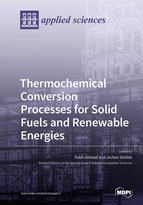Thermochemical Conversion Processes for Solid Fuels and Renewable Energies
A special issue of Applied Sciences (ISSN 2076-3417). This special issue belongs to the section "Energy Science and Technology".
Deadline for manuscript submissions: closed (30 October 2020) | Viewed by 38262
Special Issue Editors
Interests: thermal power generation (e.g., combined-cycle power plant, concentrated solar power plant, municipal waste incinerator, fluidized bed system); energy storage system and flexibility of thermal power plants; gasification and combustion of solid fuels (e.g., biomass, waste, SRF and RDF); CO2 capture and reuse (chemical-looping combustion, calcium carbonate-looping); production of methane and methanol; dynamic process simulation of energy systems and process engineering applications; CFD numerical methods of energy systems and process engineering applications (including multi-phase flow using two-fluid and euler-lagrange models)
* Priv.-Doz. Dr.-Ing. habil.
Special Issues, Collections and Topics in MDPI journals
Interests: carbon utilization & storage; conversion of low‐rank solid fuels through combustion or gasification; 3D CFD numerical methods
Special Issues, Collections and Topics in MDPI journals
Special Issue Information
Dear Colleagues,
We would like to invite submissions to a Special Issue of Applied Sciences on the subject of "Thermochemical Conversion Processes for Solid Fuels and Renewable Energies".
It is widely believed that a great share of greenhouse gas emissions is anthropogenic and originated from utilizing fossil fuels, with contributions coming from manufactured materials (e.g., concrete), deforestation, and agriculture (including livestock). Societies around the world actively support measures towards a flexible and low-carbon energy economy in order to attenuate climate change and its devastating environmental consequences. These measures include new conversion technologies such as gasification or combustion of alternative energy sources, implementation of carbon capture and storage/utilization technologies, and promotion of renewable energy sources for power generation and district heating or cooling.
This Research Topic intends to present an overview of the latest research progresses in terms of development and optimization of conversion processes and concepts, especially for intermittent renewable energy sources, with thermodynamic analysis, CFD, and process simulation of these systems. The topics of interest of this Special Issue include but are not limited to:
- Gasification and combustion of alternative fuels (e.g., biomass, refuse-derived fuel, solid recovered fuel, and low-rank coal);
- Technological combinations of conversion processes based on renewable sources (power-to-fuel);
- Carbon capture and storage/utilization CCS/U technologies (carbon capture-to-fuel);
- Renewable energy for heating and cooling purposes to reduce peak demand, including energy storage systems to mitigate grid imbalances;
- Thermodynamic study, CFD and process simulation of above-mentioned issues.
Dr.-Ing. Jochen Ströhle
Guest Editor
Manuscript Submission Information
Manuscripts should be submitted online at www.mdpi.com by registering and logging in to this website. Once you are registered, click here to go to the submission form. Manuscripts can be submitted until the deadline. All submissions that pass pre-check are peer-reviewed. Accepted papers will be published continuously in the journal (as soon as accepted) and will be listed together on the special issue website. Research articles, review articles as well as short communications are invited. For planned papers, a title and short abstract (about 100 words) can be sent to the Editorial Office for announcement on this website.
Submitted manuscripts should not have been published previously, nor be under consideration for publication elsewhere (except conference proceedings papers). All manuscripts are thoroughly refereed through a single-blind peer-review process. A guide for authors and other relevant information for submission of manuscripts is available on the Instructions for Authors page. Applied Sciences is an international peer-reviewed open access semimonthly journal published by MDPI.
Please visit the Instructions for Authors page before submitting a manuscript. The Article Processing Charge (APC) for publication in this open access journal is 2400 CHF (Swiss Francs). Submitted papers should be well formatted and use good English. Authors may use MDPI's English editing service prior to publication or during author revisions.







